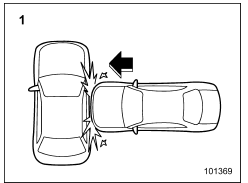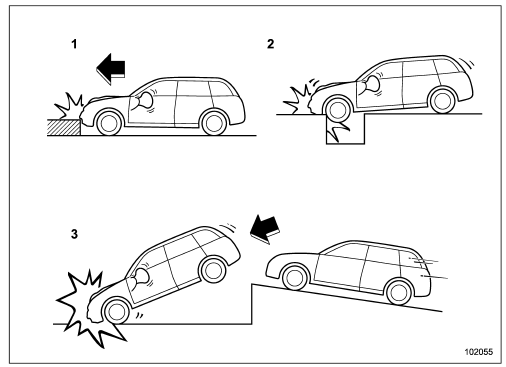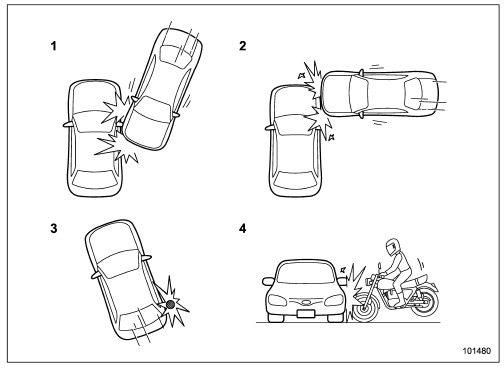Subaru Crosstrek Owners Manual: SRS side airbag and SRS curtain airbag
The SRS side airbag is stored in the door side of each front seat seatback, which bears an "SRS AIRBAG" label.

In a moderate to severe side impact collision, the SRS side airbag on the impacted side of the vehicle deploys between the occupant and the door panel and supplements the seatbelt by reducing the impact on the occupant's chest and waist. The SRS side airbag operates only for front seat occupants.
The SRS curtain airbag on each side of the cabin is stored in the roof side (between the front pillar and a point over the rear seat). An "SRS AIRBAG" mark is located at the top of each center pillar.
In a moderate to severe side impact collision, the SRS curtain airbag on the impacted side of the vehicle deploys between the occupant and the side window and supplements the seatbelt by reducing the impact on the occupant's head.
In a rollover, SRS curtain airbags on both sides of the vehicle deploy between the occupant and the side window and supplement the seatbelt by reducing the impact to the occupant's head.
In an offset frontal collision, SRS curtain airbags on both sides of the vehicle deploy between the occupant and the side window and supplement the seatbelt by reducing the impact to the occupant's head and chest.
Operation
The SRS side airbag and SRS curtain airbag can function only when the ignition switch is in the "ON" position.
The following airbags deploy independently of each other since each has its own impact sensor.
- Driver's SRS side airbag
- Front passenger's SRS side airbag
- SRS curtain airbag (right-hand side)
- SRS curtain airbag (left-hand side)
Therefore, they may not both deploy in the same accident. Also, the SRS side airbag and SRS curtain airbag deploys independently of the driver's and front passenger's SRS frontal airbags in the steering wheel and instrument panel.
An impact sensor, which senses impact force, is located in each of the following locations.
- In the left and right front doors
- In the left and right center pillars
- In the left and right rear wheel houses
- Under the rear center seat
A rollover sensor is also located inside the airbag control module.
If both of the following sensors together sense an impact force above a predetermined level in a side collision, the control module causes both the SRS side airbag and curtain airbag on the impacted side to inflate regardless of whether the rear wheel house impact sensor on the same side senses an impact.
- the impact sensor that is located under the rear center seat
- one of the center pillar impact sensors or front door impact sensors
If both of the following sensors together sense an impact force above a predetermined level in a side collision, the control module causes only the SRS curtain airbag on the impacted side to inflate
- the impact sensor that is located under the rear center seat
- one of the rear wheel house impact sensors
If the rollover sensor detects rollover of the vehicle, the control module inflates the SRS curtain airbags on both sides. At this time, the driver's and front passenger's seatbelt pretensioners also operate at the same time.
After the deployment, the SRS side airbag immediately starts to deflate. The time required from detection of an impact to deflation of an SRS side airbag after deployment is shorter than the blink of an eye.
The SRS curtain airbag remains inflated for a while following deployment then slowly deflates.
The SRS side airbag and SRS curtain airbag deploy even when no one occupies the seat on the side on which an impact is applied.
When the SRS side airbag and SRS curtain airbag deploy, a sudden, fairly loud inflation noise will be heard and some smoke will be released. These occurrences are a normal result of the deployment.
This smoke does not indicate a fire in the vehicle.
CAUTION
Do not touch the SRS side airbag system components around the front seat seatback with bare hands right after deployment. Doing so can cause burns because the components can be very hot as a result of deployment.
After deployment, do not touch any part of the SRS curtain airbag system (from the front pillar to the part of the roof side over the rear seat). Doing so can cause burns because the components can be very hot as a result of deployment.
The SRS side airbag and SRS curtain airbag are designed as follows:
- to deploy in the event of an accident involving a moderate to severe side impact collision
- to function on a one-time-only basis.
The SRS side airbag and SRS curtain airbag are not designed to deploy in the following cases:
- in most lesser side impact
- in most frontal or most rear impacts (because the SRS side airbag and SRS curtain airbag deployment would not protect the occupant in those situations)
The SRS curtain airbags are also designed to deploy when the vehicle is in an extremely inclined state such as during a rollover. They are not designed to deploy in most lesser inclined state.
SRS side airbag and SRS curtain airbag deployment depend on the level of force experienced in the passenger compartment during a side impact collision. That level differs from one type of collision to another, and it may have no bearing on the visible damage done to the vehicle itself.
Example of the type of accident in which the SRS side airbag will most likely deploy.

1) A severe side impact near the front seat.
Examples of the types of accidents in which the SRS curtain airbag will most likely deploy.

1) The vehicle is involved in a severe side impact near the front seat or the rear seat.
2) The vehicle rolls onto its side or the roof.
3) The angle of vehicle tip-up is marginal or the skidding vehicle's tires hit a curbstone laterally.
4) An offset frontal collision that is severe enough to deploy the front airbag.
Examples of the types of accidents in which it is possible that the SRS side airbag and the SRS curtain airbag will deploy.

- Hitting a curb, edge of pavement or hard surface
- Falling into or jumping over a deep hole
- Landing hard or vehicle falling
It is possible that the SRS side and curtain airbags will deploy if a serious impact occurs to the underside of your vehicle.
Some examples are shown in the illustration.
Examples of the types of accidents in which the SRS side airbag is unlikely to deploy.

- The vehicle is involved in an oblique side-on impact.
- The vehicle is involved in a side-on impact in an area outside the vicinity of the passenger compartment
- The vehicle strikes a telephone pole or similar object.
- The vehicle is involved in a side-on impact from a motorcycle.
- The vehicle rolls onto its side or the roof.
There are many types of collisions which might not necessarily require SRS side airbag deployment. In the event of accidents like those illustrated, the SRS side airbag may not deploy depending on the level of accident forces involved.
Examples of the types of accidents in which the SRS curtain airbag is unlikely to deploy.

- The vehicle is involved in an oblique side-on impact.
- The vehicle is involved in a side-on impact in an area outside the vicinity of the passenger compartment
- The vehicle strikes a telephone pole or similar object
- The vehicle is involved in a side-on impact from a motorcycle.
There are many types of collisions which might not necessarily require SRS curtain airbag deployment. In the event of accidents like those illustrated, the SRS curtain airbag may not deploy depending on the level of accident forces involved.
 Operation
Operation
Driver's side
Passenger's side
SRS AIRBAGs deploy as soon as a collision occurs.
After deployment, SRS AIRBAGs start to deflate immediately so that the
driver's vision is not
obstr ...
 SRS airbag system monitors
SRS airbag system monitors
SRS airbag system warning light (type B)
A diagnostic system continually monitors
the readiness of the SRS airbag system
(including front seatbelt pretensioners)
while the vehicle is being dri ...
Other materials:
General diagnostic table Inspection
WHEEL AND TIRE SYSTEM > General Diagnostic TableINSPECTIONSymptomsPossible causeCorrective actionWheel is out of balance.Improperly inflated tire.Adjust the tire pressure.Uneven wearCheck the tire referring to “Abnormal tire wear” in this table, carry out the procedure and replace the ...
Inspection
SEAT BELT SYSTEM > Seat Belt Warning SystemINSPECTIONCAUTION:• Before handling the airbag system components, refer to “CAUTION” of “General Description” in “AIRBAG SYSTEM”. General Description > CAUTION">• When inspecting the airbag main ...
Installation
FUEL INJECTION (FUEL SYSTEMS)(H4DO) > Engine Wiring HarnessINSTALLATION1. Route the engine wiring harness around the engine and connect connectors.• Structural diagram 1(1)Tumble generator valve actuator RH(2)Be careful of pinching when installing the intake manifold.(3)Engine harness conne ...
